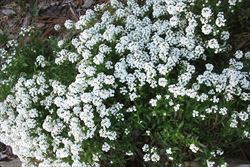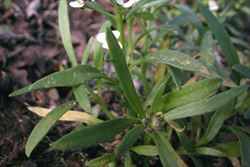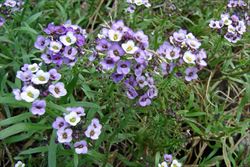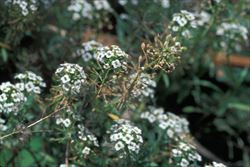Click on images to enlarge

habit (Photo: Sheldon Navie)

habit (Photo: Sheldon Navie)

close-up of elongated leaves (Photo: Greg Jordan)

white flowers (Photo: Sheldon Navie)

lilac flowers (Photo: Forest and Kim Starr, USGS)

close-up of flowers (Photo: Greg Jordan)

mature fruit (Photo: Forest and Kim Starr, USGS)

seedling (Photo: Sheldon Navie)
Scientific Name
Lobularia maritima (L.) Desv.
Synonyms
Alyssum maritimum (L.) LamAlyssum minimum L.Clypeola maritima L.Koniga maritima (L.) R. Br.
Family
Brassicaceae (Queensland, New South Wales, the ACT, Victoria, Tasmania, Western Australia and the Northern Territory)Cruciferae (South Australia)
Common Names
alyssum, carpet of snow, sea alyssum, seaside lobularia, snowdrift, sweet Alice, sweet Alison, sweet alyssum
Origin
Native to northern Africa (i.e. northern Algeria, Egypt, northern Libya, Morocco and Tunisia), the Azores, the Madeira Islands, the Canary Islands and southern Europe (i.e. France, Portugal, Spain, Italy, Albania and Greece).
Naturalised Distribution
Widely naturalised in the coastal and sub-coastal districts of south-eastern Australia (i.e. in eastern New South Wales, southern Victoria, Tasmania, south-eastern South Australia and south-western Western Australia). Also naturalised in south-eastern Queensland, on Norfolk Island and on Lord Howe Island.
Naturalised in other parts of the world, including most of the USA and some Pacific islands (i.e. Hawaii and New Caledonia).
Notes
Alyssum (Lobularia maritima) is regarded as an emerging environmental weed in Tasmania and as a potential environmental weed in other parts of southern Australia. This widely grown garden ornamental has escaped cultivation and is now a weed of parks, footpaths, roadsides, waste areas, disturbed sites and coastal environs in southern and eastern Australia.
However, as an environmental weed, alyssum (Lobularia maritima) is mainly of concern in coastal sand dunes and sandy soils in the temperate regions of the country. It has been recorded in conservation areas in New South Wales (i.e. Berkeley Nature Reserve), South Australia (i.e. Henley Beach to Tennyson Coastal Reserve), Victoria (i.e. Yarra Bend Park) and Western Australia (i.e. Ken Hurst Park).

